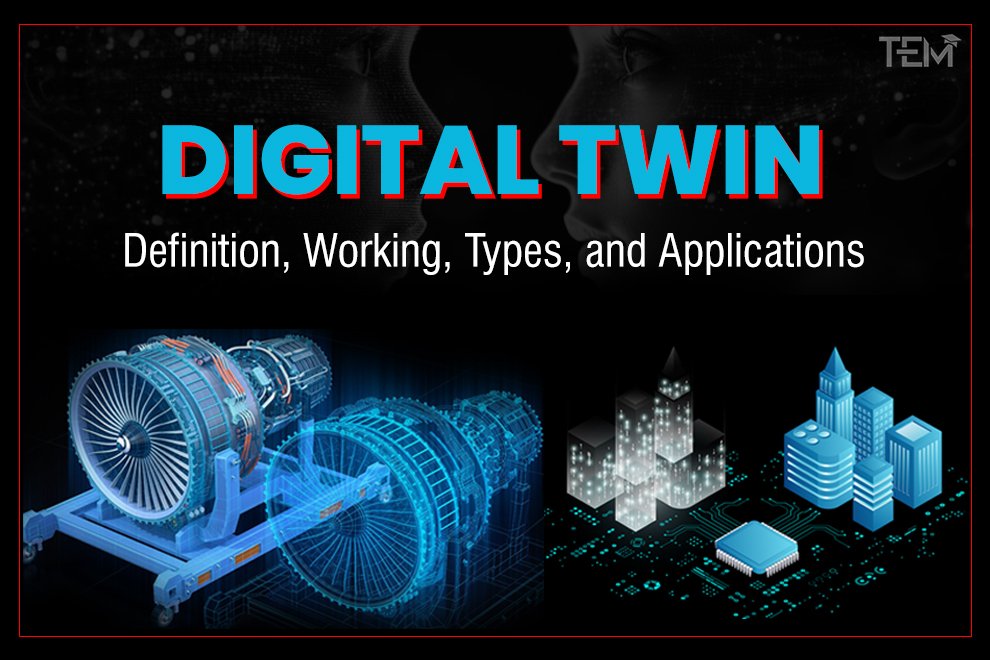Imagine a world where you could predict the future of your products, optimize your processes with pinpoint accuracy, and even design efficient cities. This isn’t science fiction; it’s the reality of digital twin technology. It is a virtual representation of physical entities.
Think of them as digital copies that mirror the behavior, and performance of their real-world counterparts. From factories to cities, from cars to medical devices, mirror twins are transforming industries across the globe. In this blog, we’ll dive deep into the exciting world of digital twins. Let’s get started
Evolution of Digital Twin Technology
| Year | Event | Key Development |
| 1960s | NASA Space Exploration | Early concept of digital clone for spacecraft simulation. |
| 1991 | Publication of “Mirror Worlds” | David Gelernter introduces the idea of virtual replicas. |
| 2002 | Michael Grieves’ Presentation | Formalizes the concept of virtual twins in product lifecycle management. |
| 2010 | NASA’s John Vickers | Coined the term “digital twin” for physical-model simulation. |
| 2010s | Industrial Adoption | Digital twins have gained traction in manufacturing, aerospace, and other industries. |
| 2020s | Advancements in IoT and AI | Increasing integration of IoT devices and AI for real-time data and predictive analytics. |
| Present | Continued Development | Expanding applications in fields like healthcare, smart cities, and autonomous systems. |
Why is Digital Twin Adoption Skyrocketing?
The rise of IoT and AI has made digital twins more effective and accessible. By collecting real-time data and running sophisticated simulations, mirror twins eliminate the need for physical prototypes and enable predictive maintenance, ultimately saving costs and improving efficiency.
Furthermore, cyber twin optimize processes, reduces waste, and helps organizations achieve sustainability goals. They are becoming central to modern industrial strategies, particularly in manufacturing and supply chains, and are key to better decision-making and risk management.
This allows businesses to
- Reduce Downtime: A digital clone can predict when maintenance is required, helping avoid costly, unplanned failures.
- Optimize Operations: By analyzing real-time data and simulations, businesses can make informed decisions, optimize efficiency, and improve overall performance.
- Scenario Planning: Virtual twins allow organizations to run “what-if” scenarios, testing potential outcomes and effects before making decisions.
How do Digital Twins impact Environmental Sustainability?
Digital twins can significantly enhance environmental sustainability. Manufacturers, for example, use cyber twins to optimize production processes, conserve resources like water and energy, and reduce pollution.
Additionally, digital copy enhances supply chain traceability, allowing better control of the product lifecycle from raw materials to production, use, and disposal.
However, it’s important to note that digital transformation initiatives, including digital clones, require robust infrastructure like data centers, which consume substantial resources.
How does Digital Twins work?
Digital twins operate by creating virtual representations of systems, processes, or physical assets. Artificial intelligence (AI), sensor data, and 3D modeling play a crucial role in building these duplicates. Here’s how it works:
1. 3D Modeling
The process begins with a 3D representation of the physical object or system. This model is created using CAD software or other modeling tools, such as 3D Scenes and Building Information Modelling (BIM).
2. Sensor data
Sensors gather real-time data from the physical object or system. It includes details like size, shape, material, and performance metrics such as vibration, pressure, and temperature.
3. Artificial Intelligence
AI algorithms connect with virtual twins to analyze and replicate the behavior of real-world objects or systems. This enables predictions of how the system will perform under different scenarios, helping identify potential issues before they arise.
4. Simulation
The mirror twins simulate how the physical object or system will behave under varying conditions like stress, wear, and environmental factors. This allows engineers to test and optimize product performance before physical construction.
5. Real-Time Monitoring
Digital twins can be connected to IoT devices for real-time monitoring of the physical object or system. This provides valuable insights into performance, helps identify problems early, and aids in maintenance and repair.
Types of Digital Twins
1. Product Digital Twin
Used during the product development phase to test and assess design options before manufacturing. This helps identify potential issues early and improve product performance.
Softwares Used: PTC ThingWorx, Siemens Teamcenter, Dassault Systèmes 3DEXPERIENCE
2. Process Digital Twin
Applied in process optimization, such as manufacturing or construction. It helps identify bottlenecks, improve efficiency, and reduce costs.
Softwares Used: Siemens Xcelerator, AVEVA Process Simulation, Honeywell Process Historian Database (PHD)
3. Asset Digital Twin
Focuses on monitoring and analyzing the performance of physical assets like machines or structures. Real-time insights can lead to better maintenance and repair.
Softwares Used: IBM Maximo, GE Digital Predix, Siemens MindSphere
4. City Digital Twin
Simulates the performance of cities or metropolitan regions. City planners can use it to prepare for scenarios such as population growth, emergency response, and traffic management.
Softwares Used: Bentley Systems OpenCities, Siemens City Intelligence Platform, Microsoft Azure Digital Twins
5. Human Digital Twin
Models human behavior and performance. This type of digital clone is particularly useful in healthcare for testing interventions and rehabilitation strategies.
Softwares Used: IBM Watson Health, Philips HealthSuite, Optum Insight
Digital Twin vs. Virtual Reality: What’s the Difference?
While both cyber twin technology and virtual reality (VR) involve simulations, their purposes differ significantly:
| Feature | Virtual reality | Digital twin technology |
| Purpose | Immersive experiences, simulations, and entertainment | Replicating physical objects or systems for analysis and optimization |
| Scope | Primarily focused on user interaction and experience | Focused on accurate representation and real-time data integration |
| Core Technology | 3D graphics, motion tracking, and sensory feedback. | IoT, data analytics, AI, and machine learning. |
| Application | Gaming, training, education, architecture, and design | Manufacturing, engineering, healthcare, and urban planning |
| Environmental Impacts | Limited direct impact on sustainability | Reduces waste, energy consumption, and carbon emissions |
| Recent Developments | Advancements in HMD technology, haptic feedback, and wireless solutions | Increasing integration with AI, machine learning, and IoT for more complex simulations. |
Applications of Digital Twins Technology
- Digital twins simulate production processes and equipment. This process allows manufacturers to make effective operations, predict maintenance needs, and improve product design.
- The digital copy of patients simulates treatments and predicts outcomes in the healthcare sector. This results in personalizing medical interventions and improving patient care.
- Digital twins of cities help in urban planning by simulating traffic flows, energy usage, and environmental impacts. However, this enables more efficient management and development.
- Car manufacturers use mirror twins to design, test, and optimize vehicles. They simulate driving conditions to enhance safety features and performance.
- Digital clones of power plants and grids optimize performance in the energy sector. This process helps in predicting failures and improves the management of resources.
- Aerospace companies use virtual twins to model aircraft systems and components, allowing for better design, testing, and maintenance.
- Digital twins of buildings and infrastructure projects help in managing construction processes. Also, it contributes to monitoring structural integrity and planning maintenance.
- Retailers use cyber twins to optimize store layouts, supply chain logistics, and customer experiences in different scenarios.
- In agriculture, digital copies of farms and crops help monitor growth and manage resources effectively.
- Mirror twins of supply chain networks allow companies to optimize inventory management, track shipments, and enhance overall efficiency.
The Future of Digital Twin Technology
1. Growth Into New Space: Sectors and Industries
Digital copy has its origins in manufacturing and aerospace. They will eventually be used in a wide range of industries, including healthcare, retail, energy, and transportation.
The adaptability of cyber twins will encourage innovation across a range of industries, from monitoring patient health to simplifying supply networks.
2. Cloud-Based Solutions and Digital Twins as a Service (DTaaS)
As cloud-based solutions like virtual twins as a Service (DTaaS) gain popularity, mirror twins technology will become more accessible.
They promise accessibility and affordability for organizations of all sizes by this change. The DTaaS models are scalable, adaptable, and don’t require a lot of infrastructure.
3. Use Extended Reality (XR) with Fusion to Create Immersive Experiences
We need to be prepared for the combination of augmented reality (AR) and virtual reality (VR) with digital twins and extended reality (XR).
This combination will create immersive experiences that transform decision-making, cooperation, and visualization. Engineers and technicians will use digital clone data to overlay physical assets with real-time guidance.
Conclusion
We hope this blog post has helped you understand digital twins. They’re revolutionizing industries by creating virtual replicas. From product design to process optimization, their potential is immense. Additionally, as technology advances, we’ll see even more innovative applications. Cyber twins are crucial for businesses aiming to improve efficiency, reduce costs, and innovate. Follow our social media for more updates on this exciting technology!
Facebook: https://www.facebook.com/TheEducationMagazine
Linkedin: https://www.linkedin.com/company/14633191/admin/feed/posts/
Twitter: https://twitter.com/TheEducationMag










